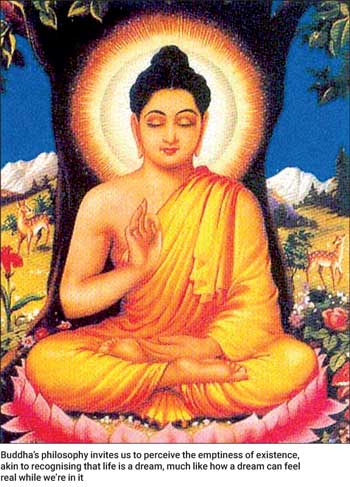Monday Jan 12, 2026
Monday Jan 12, 2026
Friday, 23 February 2024 00:07 - - {{hitsCtrl.values.hits}}
 Buddha may not be credited with inventing groundbreaking scientific discoveries like the law of gravity, the steam engine, or penicillin. Still, he stands as a scientist par excellence who unravelled the causes and remedies for human suffering. His teachings, imparted to spiritual seekers, encompassed both mundane and supra-mundane aspects.
Buddha may not be credited with inventing groundbreaking scientific discoveries like the law of gravity, the steam engine, or penicillin. Still, he stands as a scientist par excellence who unravelled the causes and remedies for human suffering. His teachings, imparted to spiritual seekers, encompassed both mundane and supra-mundane aspects.
The mundane teachings outlined a path to a life devoid of conflict, as evidenced in discourses such as Singalowada, Parabhawa, Mangala, Ratana, and Karaneeyametta, among thousands of others. Yet, Buddha’s true innovation lay in his profound exploration of the nature of existence, a revelation that is currently gaining widespread recognition though among smaller segments of seekers across the globe.
The message aimed at liberating humanity from psychological suffering due to stress, anxiety, worry, anger, hatred, undue competition, overthinking, and egocentrism, among other afflictions. To understand this message fully, we must turn to the supra-mundane teachings that sought to convey what words alone could not express. Here are a few key insights present in these discourses.

In the Anattalakkhana Sutta (SN 22.59), Buddha’s second discourse, he expounded on the absence of a self in image, sensations, perceptions, mental formations, and consciousness. These elements, he argued, are transient appearances that emerge and disappear.
Similarly, the Rohitassa Sutta (AN 4.45) illuminates the concept that everything is one. The conventional association of the self with the physical body is debunked, with the true self encompassing all facets of the universe, including thoughts, feelings, and perceptions. Meanwhile, the Mahă-Nidăna Sūtta (DN 15) posits that appearances are a result of cause and effect, devoid of a singular doer.
The Dhammapada (Tilakkhaṇa 277, 278, 279) underscores the three fundamental marks of existence: impermanence (anicca), suffering (dukkha), and non-self (anattā). Among these, anatta is the most profound concept in Buddhist philosophy, capable of dismantling all fallacies. The Mogharaja Sutta, Cula Sunnata sutta introduce the notion of “sunyata,” or emptiness, which has become a focal point in contemporary Western non-dualistic discourse though not that much discussed in Sri Lanka.
The Lokavipatti Sūtta (AN 8.6) offers insights into the ever-turning wheel of worldly conditions. Buddha observed how eight worldly conditions – gain, loss, status, disgrace, censure, praise, pleasure, and pain – perpetually engage and shape the world.
These teachings serve as profound revelations that Buddha brought to humanity, but they are subject to interpretation and presentation by various teachers, both monastic and lay preachers. Buddha’s essential message is spreading, not necessarily due to fervour in Sri Lanka but thanks to newly emerged sages.
These core messages present radical interpretations that resonate with certain segments of society. Buddha’s teachings extend far beyond mere adherence to precepts and ritualistic offerings; they invite us to recognise the illusory nature of existence – a magician’s trick.
However, dispelling this illusion is not an illusion in itself, and therein lies the quandary that humans grapple with. This realisation underscores the necessity of a metaphorical “third eye” – a tool for subtle analysis to awaken within the dream because there is no awakening FROM the dream.
This perspective, even without complete comprehension, holds a certain logic that challenges mundane beliefs. Wise seekers begin to realise that Buddha’s message is not a matter of mere sight but a fundamental shift in perspective that views life through an entirely different lens.
Buddha’s philosophy invites us to perceive the emptiness of existence, akin to recognising that life is a dream, much like how a dream can feel real while we’re in it. This revelation doesn’t demand an extensive knowledge base or intricate practices.
It calls for sharp analytical skills which recognise the true meaning of what is said through pointers. Interestingly, figures like Sunettha, Sopaka, Kujjuththra, and Rajjumala, ordinary individuals of their time, embodied this insight. Thus, Buddha’s message appears remarkably simple, yet it often eludes those mired in complexity.
(The writer is a former diplomatic envoy, tourism official and currently a meditation teacher and healing therapist.)